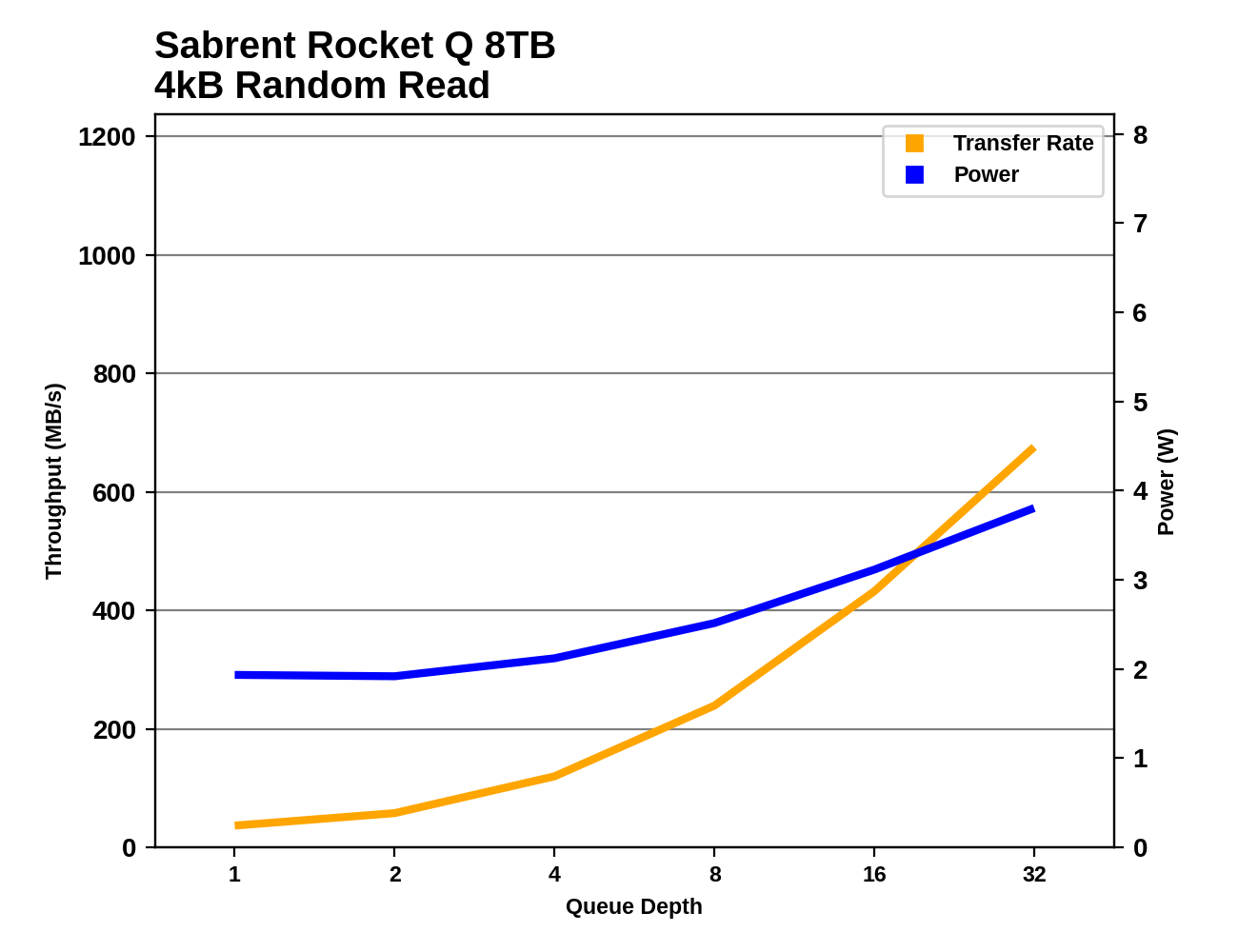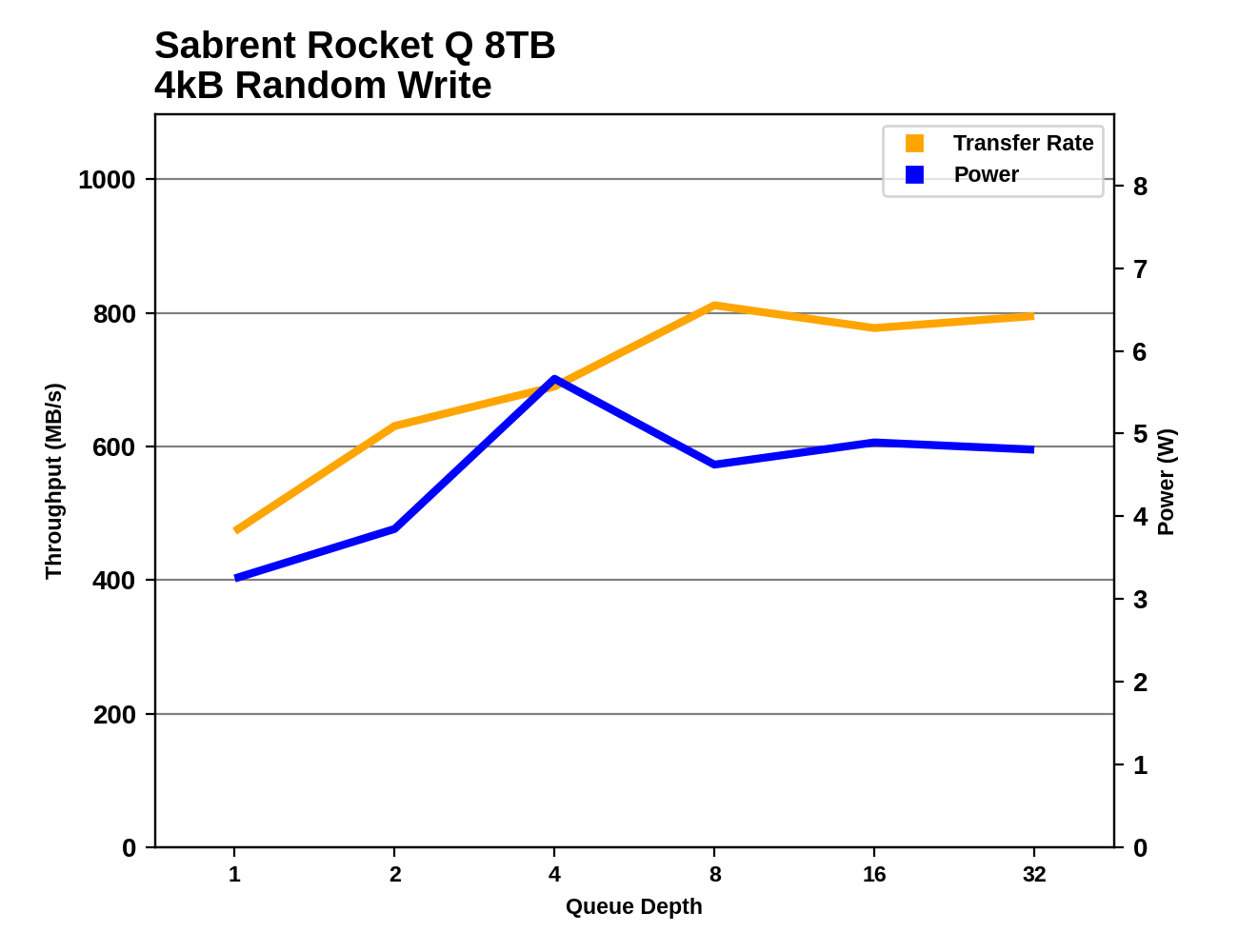QLC Goes To 8TB: Samsung 870 QVO and Sabrent Rocket Q 8TB SSDs Reviewed
by Billy Tallis on December 4, 2020 8:00 AM ESTRandom Read Performance
Our first test of random read performance uses very short bursts of operations issued one at a time with no queuing. The drives are given enough idle time between bursts to yield an overall duty cycle of 20%, so thermal throttling is impossible. Each burst consists of a total of 32MB of 4kB random reads, from a 16GB span of the disk. The total data read is 1GB.

The burst random read performance from the 8TB Samsung 870 QVO is even worse than the smaller 870s; even though these drives have the full amount of DRAM necessary to hold the logical to physical address mapping tables, there are other significant sources of overhead affecting the higher capacity models.
The Sabrent Rocket Q's burst random read performance doesn't quite fall at the opposite end of the spectrum, but it does clearly offer decent random read latency that is comparable to other drives using the Phison E12(S) controller and not too far behind the NVMe drives using Silicon Motion controllers.
Our sustained random read performance is similar to the random read test from our 2015 test suite: queue depths from 1 to 32 are tested, and the average performance and power efficiency across QD1, QD2 and QD4 are reported as the primary scores. Each queue depth is tested for one minute or 32GB of data transferred, whichever is shorter. After each queue depth is tested, the drive is given up to one minute to cool off so that the higher queue depths are unlikely to be affected by accumulated heat build-up. The individual read operations are again 4kB, and cover a 64GB span of the drive.

The QLC drives almost all fare poorly on the longer random read test. The Sabrent Rocket Q falls to be the second-slowest NVMe drive in this batch, and a bit slower than Samsung's TLC SATA drives. The 8TB Samsung 870 QVO is no longer the slowest capacity; while it is again a bit slower than the 4TB model, the 1TB 870 QVO takes last place in this test.
 |
|||||||||
| Power Efficiency in MB/s/W | Average Power in W | ||||||||
The power efficiency scores are mostly in line with the performance scores, with the slower drives tending to also be less efficient. The QLC drives follow this pattern quite well. The outliers are the particularly efficient Mushkin Helix DRAMless TLC drive, and the enterprise NVMe SSDs that show poor efficiency because they are underutilized by the low queue depths tested here.
 |
|||||||||
The Sabrent Rocket Q shows good performance scaling as queue depths increase during the random read test. The Samsung 870 QVO seems to be approaching saturation past QD16, even though the SATA interface is capable of delivering higher performance.
 |
|||||||||
| Sabrent Rocket Q 8TB | Samsung 870 QVO 8TB | ||||||||
Comparing the 8TB drives against everything else we've tested, neither is breaking new ground. Both drives have power consumption that's on the high side but not at all unprecedented, and random read performance that doesn't push the limits of their respective interfaces.
Random Write Performance
Our test of random write burst performance is structured similarly to the random read burst test, but each burst is only 4MB and the total test length is 128MB. The 4kB random write operations are distributed over a 16GB span of the drive, and the operations are issued one at a time with no queuing.

The two 8TB drives have opposite results for the burst random write performance test. The 8TB Sabrent Rocket Q it at the top of the chart with excellent SLC cache write latency, while the 8TB Samsung 870 QVO is a bit slower than the smaller capacities and turns in the worst score in this bunch.
As with the sustained random read test, our sustained 4kB random write test runs for up to one minute or 32GB per queue depth, covering a 64GB span of the drive and giving the drive up to 1 minute of idle time between queue depths to allow for write caches to be flushed and for the drive to cool down.

On the longer random write test, the 8TB Rocket Q is still relying mostly on its SLC cache and continues to hang with the high-end NVMe drives. The 8TB 870 QVO is only slightly slower than the other SATA SSDs, and faster than some of the low-end DRAMless TLC NVMe drives.
 |
|||||||||
| Power Efficiency in MB/s/W | Average Power in W | ||||||||
Despite their dramatically different random write performance, the two 8TB QLC drives end up with similar power efficiency that's fairly middle of the road: better than the enterprise drives and the slow DRAMless TLC drives, but clearly worse than the better TLC NVMe drives.
 |
|||||||||
The random write performance of the Rocket Q scales a bit unevenly, but seems to saturate around QD8. Power consumption actually drops after QD4, possibly because the drive is busy enough at that point with random writes that it cuts back on background cleanup work. The Samsung 870 QVO reaches full random write performance at QD4 and steadily maintains that performance through the rest of the test.
 |
|||||||||
| Sabrent Rocket Q 8TB | Samsung 870 QVO 8TB | ||||||||
Unlike on the random read test, the Samsung 870 QVO comes across as having reasonably low power consumption on the random write test, especially at higher queue depths. The Sabrent Rocket Q's power consumption is still clearly on the high side, especially the spike at QD4 where it seemed to be doing a lot of background work instead of just directing writes to the SLC cache.










150 Comments
View All Comments
Oxford Guy - Tuesday, December 8, 2020 - link
Samsung doing it isn’t shocking. It’s Samsung after all.Palorim12 - Monday, December 14, 2020 - link
idk if you remember when they did the change from TLC to 3-bit MLC, but I member. It was after all that stuff went down with the 840 EVO. Despite all TLC having this issue across all brands, Samsung was the first to push TLC, so when the slow down issue creeped up, Samsung got the brunt of the complaints, and ppl to this day will use that as a reason as why Samsung "sucks", despite the fact that the issue started creeping up on sandisk and other TLC drives that had entered the market much later after Samsung did. And by the time Samsung figured out the problem and fixed it, all the other manufacturers copied the fix and then really started pushing their own TLC products.And TBH, TLC products since then have been pretty good. I recommend 850 EVOs, and now 860 EVOs to all my friends who want to switch to SSDs but are worried about the price. I've only recommended 2-bit MLC drives to ppl who I know will hit the drive had with writes with the type of work they do.
at_clucks - Wednesday, December 9, 2020 - link
@shabby, other companies have done worse if you ask me, like switching from MLC to TLC mid way through a product's run. Good luck with identifying the exact type of NAND based on decoding a SN without having the decoder ring, especially when the product is still in the store's warehouse.phoenix_rizzen - Monday, December 7, 2020 - link
Switching to a number would really simplify things.1LC
2LC
3LC
4LC
...
But since when has logic been part of marketing?
Billy Tallis - Monday, December 14, 2020 - link
I've already pretty much decided that if we ever get real products that store 5 bits per cell, I won't use any abbreviations that don't include the numeral 5. Stuff like 3bpc, 4bpc, 5bpc would make a lot more sense than current industry conventions.redzo - Tuesday, December 22, 2020 - link
This. It's been a long time since my last post at anand.Consumers have no idea of what they are purchasing. They are basically sheep.
QVO is nice if it is priced right. It should be priced way less.
I just purchased a 3d nand TLC 1TB for less than an intel/crucial/samsung qvo equivalent. This is not right. Manufacturers of NAND flash and product manufacturers are taking advantage of misinformed consumers.
More so. Most products are missing important specs like controller model, dramless or not, or even NAND type. This is just ridiculous.
dontlistentome - Saturday, December 5, 2020 - link
If you want MLC or TLC then buy it - they cost more because they cost more to make. I've just bought a 2TB SSD for the old man - paid the 15% or so extra for TLC over QLC.There's no conspiracy here or evil manufacturers. They do R&D then offer a product and see if consumers buy it. Almost all consumers, even those that claim not to be are driven pricipally by price, hence QLC being populat when the buyer looks at the ticket.
Oxford Guy - Sunday, December 6, 2020 - link
Economy of scale makes your comment fail.DigitalFreak - Monday, December 7, 2020 - link
+1 for your mad rhyming skills.Kangal - Tuesday, December 8, 2020 - link
Lmao.But for real, I thought we would have hit 8TB Sata-SSDs like last year for around USD $650. Instead I'm seeing these still yet to launch proper, and priced around $1,000. It's definitely true the market isn't dominated as much by the consumers, as it is dominated by the actual suppliers.